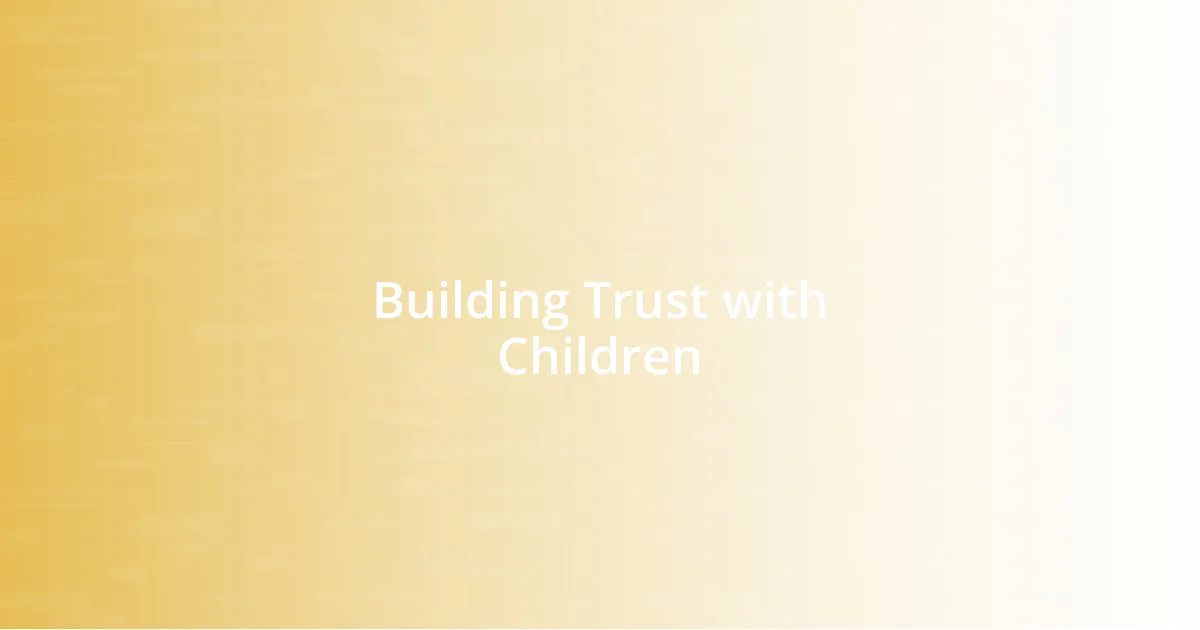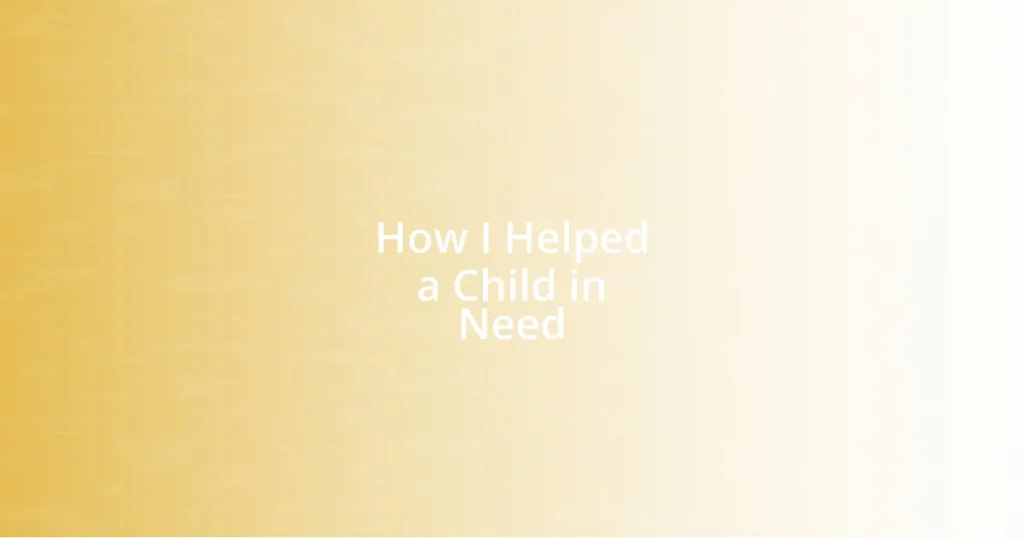Key takeaways:
- Understanding a child’s emotional needs is crucial; engaging them in conversations can help them process feelings like grief and anxiety.
- Identifying children in need involves keen observation, active listening, and collaboration with adults in their lives.
- Building trust requires consistency, genuine interest, and creating a safe environment for children to express themselves.
- Engaging community resources, such as local youth centers and libraries, enhances support for children facing social and emotional challenges.

Understanding Child Needs
Understanding a child’s needs requires more than just observing their behavior; it’s about tuning into their emotional landscape. I remember a time when my neighbor’s daughter, Sarah, seemed withdrawn. It made me wonder—what could be troubling her beneath that quiet exterior? When I reached out, I discovered she was grappling with anxiety about school.
Emotional needs play a pivotal role in a child’s overall development. I’ll never forget the moment I supported a young boy named Leo during a difficult time; he had just lost his pet. Watching his face light up when I engaged him in a conversation about his favorite memories with his pet was a powerful reminder of how emotional support can help a child process grief. How many children out there are grappling with unexpressed feelings and just need someone to listen?
Beyond emotional needs, practical support also shapes a child’s well-being. For instance, tutoring a child who struggles academically not only boosts their confidence but also helps them feel more secure in their environment. I learned that understanding a child’s needs holistically is vital; it fosters their growth in a loving and supportive way. Isn’t it heartwarming to think about the difference we can make in their lives with an open heart?

Identifying Children in Need
Identifying children in need begins with keen observation. I recall a situation at my local community center when I noticed a boy named Sam sitting alone during a group activity. His body language screamed discomfort—he was hunched over, avoiding eye contact. It struck me that sometimes, physical signs can reveal deeper emotional struggles that are not immediately apparent.
Listening carefully plays a crucial role in this identification process. There was a young girl named Mia who often spoke in whispers, and it took me a while to realize she had a hard time standing up for herself. It was only after sitting down with her and prompting her to share her thoughts that she opened up about feeling bullied at school. This experience highlighted how essential it is to create a safe space for children to express themselves.
In my experience, collaboration with teachers and caregivers further aids in recognizing children in need. During a parent-teacher meeting, I learned about a classmate of my son who had been frequently absent and acting out. It became evident that his challenges were rooted in instability at home. When concerned adults connect, they can collectively nurture the child’s environment, ultimately contributing to their well-being.
| Signs of Need | Examples |
|---|---|
| Emotional Indicators | Withdrawal, mood swings |
| Behavioral Changes | Acting out, difficulty concentrating |
| Communication | Limited or fragmented speech |
| Physical Signs | Poor hygiene, signs of neglect |

Building Trust with Children
Building trust with children is a nuanced journey that requires patience and authenticity. When I volunteered at a local after-school program, I found that simply being present made a significant difference. I remember a young boy, Ethan, who was skeptical about my intentions at first. By consistently showing up and engaging him in games he loved, I slowly broke down those barriers. Trust is built over time through reliability and genuine interest, and children are incredibly perceptive to sincerity.
Establishing trust involves creating a safe environment where children feel comfortable sharing their feelings. Here’s how I fostered that connection:
- Active Listening: I made it a point to listen intently when they talked about their day or their worries, reflecting back what I heard to show I understood.
- Consistency: To help Ethan feel secure, I maintained regular visits and followed through on promises like bringing his favorite books.
- Empathy: By sharing my own experiences with setbacks, children began to see me as someone who understood their struggles, promoting deeper conversations.
- Positive Reinforcement: Complimenting not just achievements, but efforts as well, encouraged them to share more openly and take risks in our interactions.
These small actions, rooted in genuine care, played an essential role in developing trust. I learned that when children feel safe and valued, they are far more likely to open up, allowing meaningful connections to flourish.

Developing a Support Plan
Creating a successful support plan begins with understanding the individual needs of the child. I remembered working with a bright girl named Lily, who struggled with anxiety during social interactions. By sitting down with her and drawing out her feelings about specific situations, we identified key stressors—like group projects and lunchtime. This insight laid the groundwork for tailor-made strategies that could empower her.
Next, we carefully crafted actionable steps for each identified challenge. For Lily, we set a goal of gradually participating in group activities, starting with small, manageable settings. I encouraged her to voice her thoughts, even if it meant just sharing one idea. Celebrating these small victories boosted her confidence and made the support plan feel less daunting. How often do we overlook those tiny successes while aiming for the bigger picture?
Collaboration with others is essential in this journey. I involved Lily’s parents and teachers, ensuring that everyone was on the same page. Together, we established checkpoints to discuss her progress. This community effort made Lily feel supported on multiple fronts. From my experience, the more eyes and hearts dedicated to her success, the more empowered she felt overall. Ultimately, a well-rounded support plan not only addresses immediate needs but also fosters a sense of security and belonging in the child.

Providing Emotional Support Techniques
When it comes to providing emotional support, one technique I found particularly effective is validating feelings. I once worked with a young girl named Mia, who often felt overwhelmed during family gatherings. I remember sitting with her on the porch, letting her express her anxieties without interruption. It was empowering for her to hear phrases like, “It’s completely okay to feel that way,” and to see that her feelings were not only acknowledged but also respected. Have you ever noticed how simply feeling heard can transform one’s emotional landscape?
Another key method I employed was the use of creative expression. I introduced Mia to journaling—an idea I embraced personally during my own tough times. As she began to write stories about her feelings, it became a safe outlet for her emotions. Gradually, I noticed a change in her demeanor. It was as if a weight had lifted; she was learning to process her experiences rather than bottle them up. How powerful is the act of putting pen to paper in navigating emotional storms?
Lastly, incorporating routine check-ins helped maintain an open line of communication. I set aside a few minutes at the end of our sessions to simply ask, “What’s on your mind today?” This small but consistent gesture encouraged her to openly share anything that might have been bothering her. From my experience, establishing this rhythm helped Mia feel that her thoughts mattered, paving the way for deeper conversations and emotional growth. The journey of understanding and supporting a child’s emotional needs truly thrives on these intentional practices.

Engaging Community Resources
Engaging community resources can unlock a wealth of support for a child in need. I recall a time when I reached out to a local youth center while assisting a boy named Josh, who faced challenges in his social skills. The center not only offered workshops but also connected me with a mentor who had similar experiences. This partnership made a tremendous difference for Josh—he was able to see someone he could relate to, which inspired him to open up more.
In another instance, I discovered that local libraries often host programs tailored for children struggling with anxiety. It’s fascinating how community resources can provide that gentle nudge towards connection. I encouraged Josh to participate in a storytelling workshop, and over time, he transformed the shyness of his initial visits into eager participation. Have you ever noticed how engaging in group activities can ease those feelings of isolation?
Building relationships with local schools was equally vital. I reached out to Josh’s teachers, sharing insights from our sessions and inviting them to offer their support during school hours. Together, we created a consistent environment for him, ensuring he felt safe not just at home but also at school. From my perspective, tapping into these community resources fosters a sense of collaborative care that can truly uplift a child in need.

Measuring Impact and Success
Measuring the impact of the support offered is crucial in understanding the effectiveness of my efforts. I vividly remember receiving a heartfelt note from Mia after a few months of our sessions. In it, she wrote about how excited she felt to share her thoughts, something that had once seemed daunting to her. This simple piece of paper felt like a testament to progress—a tangible reminder that even seemingly small encouragements can ignite profound changes.
Quantifying success isn’t just about emotional milestones; it also involves observing behavioral shifts. I noticed that Josh began to express himself more freely during our sessions. At first, he struggled to make eye contact, but soon he was animatedly discussing his thoughts and experiences. Reflecting on these moments, I couldn’t help but question: How often do we overlook the silent victories in a child’s journey? It’s these less visible markers that truly reflect their growth.
In my experience, consistent feedback from parents and teachers plays a pivotal role in measuring success. After a shared workshop with Josh’s class, his teacher remarked on how he had begun initiating conversations with peers. These observations echoed what I had been feeling: that real progress comes when a child starts to integrate what they’ve learned into various aspects of their life. It’s incredibly rewarding to realize that our collective efforts can lead to a ripple effect of positive change in a child’s world.












